Menus
- Triumph Daytona 1050 from the tuning company
- drive
- landing gear
- ergonomics
- Conclusion and horsepower data
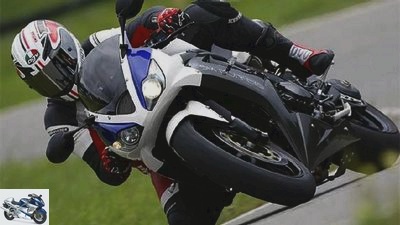
Artist
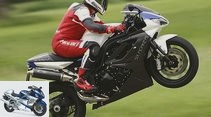


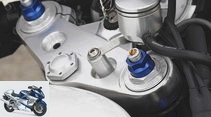
10 photos

Artist
1/10
Six Monkeys Daytona 1050: A bit too soft for a nasty super sports car on the hunt for tenths of a second, the chassis fits perfectly on small side streets, is soft as butter and filters away even bad bumps.
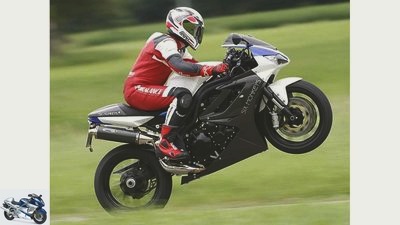
Artist
2/10
The wasteful torque of the 1050 makes unicycle insoles a breeze.
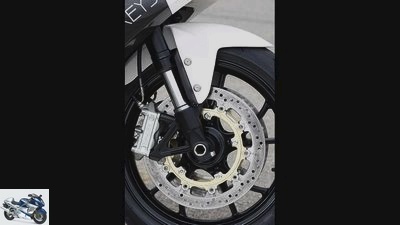
Artist
3/10
Six Monkeys Daytona 1050
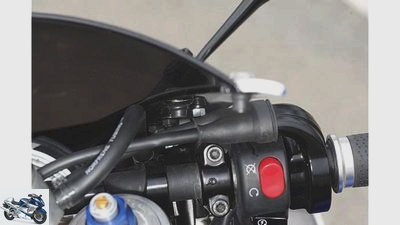
Artist
4/10
When maneuvering, the brake pump is on the fairing bracket.
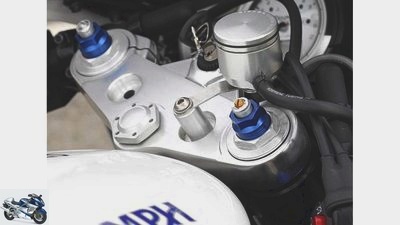
Artist
5/10
Instead of handlebar brackets, the fork bridge now carries the expansion tank.

Artist
6/10
Six Monkeys Daytona 1050: The Wilbers shock absorber works great on country roads.

Artist
7/10
The Daytona 1050 from Six Monkeys shows what a beautiful, sporty and high-torque big Triumph could look like. …
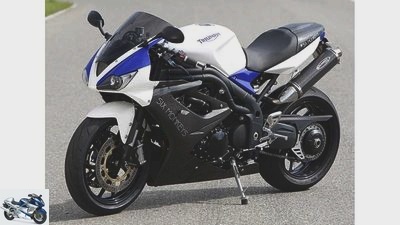
Artist
8/10
Triumph tuner Steffen Hoffmann from Six Monkeys took heart, took a current Speed Triple and began to work on a Daytona 1050 on his own.
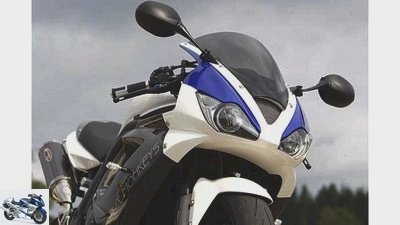
Artist
9/10
… But it also shows that no thoroughbred superbike can be built on the basis of the Speed Triple engine.
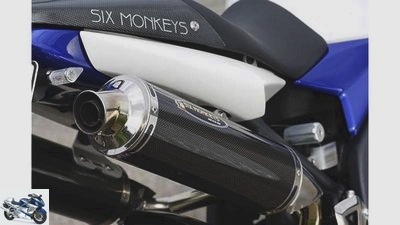
Artist
10/10
Chic and sonorous: the BOS mufflers impress visually and acoustically.
Single test: Six Monkeys Triumph Daytona 1050
Triumph Daytona 1050 from the tuning company
Content of
Ever since Triumph launched the Daytona 675 and stirred up the supersport world, fans have been dreaming of an adequate three-cylinder superbike. Now the time has finally come – thanks to the tuning company Six Monkeys.
Is it coming or not coming? Since the lackluster end of the Triumph Daytona 955i and the simultaneous impact of the 675 in 2006, there have been rumors of a new Triumph Superbike. If the new sporty three-cylinder could build on the level of its little Supersport sister, it would stir up the field of thousands. But perhaps precisely because of the high expectations, only nebulous information comes over from the island on request. "The development costs of a superbike are immense and can only be refinanced with good sales figures. Landing a flop in this market segment can therefore have particularly devastating effects on the company. We constantly monitor all market segments and developments worldwide. If we see good opportunities in the market for a Triumph Superbike, the development of such a vehicle cannot be ruled out", so the official statement of the German Triumph press spokesman Uli Bonsels. Wait and see and drink tea instead of concrete facts. In view of such gloomy prospects, Triumph tuner Steffen Hoffmann from Six Monkeys (www.sixmonkeys.de) took heart, took a current Speed Triple and began to tinker with a Daytona 1050 on his own.
The result is impressive: carbon fiber side panels and the front of a Daytona 675 merge with the bare Speedy to create an attractive superbike. Instead of tubular handlebars, there are stubs equipped with Rizoma handles, strut and fork springs are from Wilbers and are intended to give the Daytona 1050 a crisp chassis.
drive
Beautiful BOS carbon pots underline the sporty overall impression of the converted Speed Triple and, supported by a converted airbox and corresponding mapping changes, elicit one or the other additional British horsepower from the engine. On the test bench, the Six Monkeys Daytona presses 134 hp and 107 Nm – about the same as the last hp test Speedy, whose horses were very good at feeding. An ideal drive for the country road. There the Six Monkeys clearly feels at home, hums powerfully out of the curves with a powerful, sonorous treble sound from 3500 rpm and accelerates linearly towards the rev limiter. The throttle response is as smooth as butter, even the otherwise somewhat rustic transmission is surprisingly powerless to operate. Easy going with a lot of fun potential and a lot of pressure in the kettle.
landing gear




10 photos
Pictures: Single test: Six Monkeys Triumph Daytona 1050
To home page
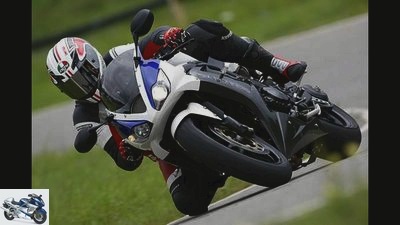
Artist
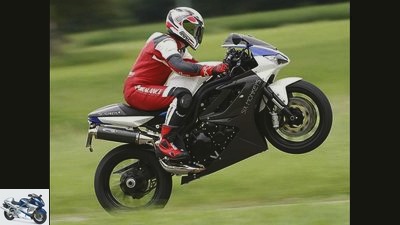
Artist
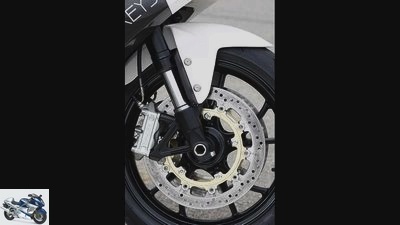
Artist
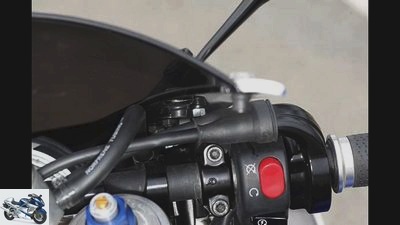
Artist

Artist
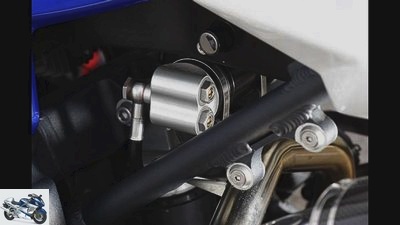
Artist
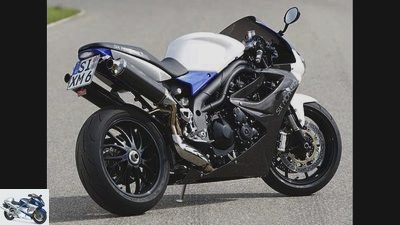
Artist
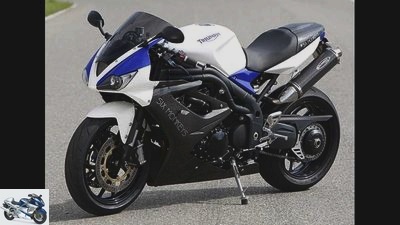
Artist
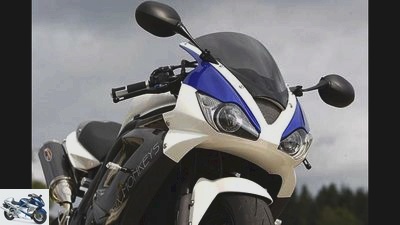
Artist
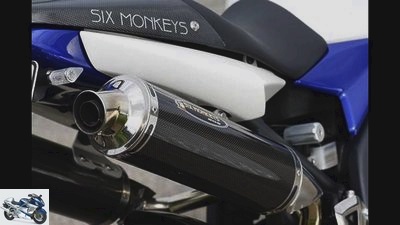
Artist
The Six Monkeys only reacted to slight steering corrections after exerting a great deal of force, only to suddenly tip over into a lean position. Research into the cause in the PS workshop uncovered a defective steering head bearing. The extent to which this problem is also responsible for the rather sluggish handling in larger inclines and when changing direction could not be conclusively clarified due to the lack of an intact steering head bearing. The Daytona’s brake system works without any problems, and apart from a stylish Rizoma brake lever, it has remained unchanged from the series. With a full bite and easily controllable, the great Triumph can be mercilessly compressed in front of tight turns.
ergonomics




10 photos
Pictures: Single test: Six Monkeys Triumph Daytona 1050
To home page

Artist

Artist

Artist

Artist

Artist

Artist

Artist

Artist

Artist

Artist
Conclusion and horsepower data
Above all, the torque curve of the Six Monkeys Daytona delights the pilot’s heart: from 3500 rpm, more than 100 Nm are constantly available. The performance curve is exemplary linear, but has not yet reached its zenith at the limiter speed. Maybe more could be done here. Overall, the performance values of the 1050, tuned via mufflers, mapping and airbox, differ only slightly from the last PS test Speedy, which was very good in the feed with 135 PS.
Conclusion:
Six Monkeys with their Daytona do not necessarily meet the Triumph fans who are impatiently waiting for a competitive 180 hp superbike, but they do delight fans of exclusive, sporty country motorcycles. The Daytona 1050 shows what a beautiful, sporty, high-torque big Triumph could look like. But it also shows that no thoroughbred superbike can be built on the basis of the Speed Triple engine.
The slightly slimmed-down customer motorcycles, which are offered without airbox conversion, with series mapping and series tires, should be available from October and cost just under 20,000 euros.
PS data
Six Monkeys Triumph Daytona 1050
Drive: Three-cylinder in-line engine, four valves / cylinder, 97 kW (132 hp) at 9250 / min *, 105 Nm at 7500 / min *, 1050 cm3, bore / stroke 79.0 / 71.4 mm, compression ratio 12.0: 1 , Ignition / injection system, 46 mm throttle valves, hydraulically operated multi-plate oil bath clutch, six-speed gearbox,
Landing gear: Light alloy bridge frame, steering head angle: 66.5 degrees, caster: 84 mm, wheelbase: 1429 mm. Upside-down fork, Ø fork inner tube: 45 mm, adjustable in spring base, rebound and compression stage, central spring strut with deflection, adjustable in spring base, rebound and compression stage
Wheels and brakes: Light alloy cast wheels, 3.50 x 17"/5.50 x 17", Front tires: 120/70 ZR 17, rear: 180/55 ZR 17. Tires: Dunlop Qualifier RR. 320 mm double disc brake, four-piston fixed calipers at the front, 220 mm single disc with two-piston floating caliper at the rear
Measurements and weight: Length / width / height 2130/780/1260 mm, seat / handlebar height 860/825 mm, handlebar width 680 mm, 221 kg fully fueled, front / rear 50% / 50%
Rear wheel power in last gear: 91 kW (123 PS) at 241 km / h
Driving performance: Acceleration 0 ?? – 100/150/200 km / h 3.2 s / 6.1 s / 10.8 s, torque 50 ?? – 100/100 ?? – 150 km / h 4.6 s / 4, 8 s
Top speed: 240 km / h *
Consumption: Fuel type: Super unleaded. Average test consumption: 7.2 liters / 100 km, tank capacity 18 liters, range: 250 km
Price test motorcycle: 22,000 euros
Tuning measures: Upper part of the fairing, headlights and mirrors from Triumph Daytona 675, carbon side panels, seat and rear wheel covers from Six Monkeys, brake and clutch levers, handlebar grips, indicators and reservoirs from Rizoma, shock absorbers, fork springs from Wilbers, carbon mufflers from BOS, Airbox and Mapping changed, tires changed to Dunlop Qualifier RR.
* Factory specification
** Performances on the crankshaft, measurements on Dynojet roller test bench 150
Related articles
-
Gargolov Top test Triumph Daytona 955i Shadow plays While Japanese and Italian sports cars compete in a merciless race for performance in the glaring…
-
Comparison test Ducati 996 S, Honda CBR 900 RR, Triumph Daytona 955i
PhotoGargolov Comparison test Ducati 996 S, Honda CBR 900 RR, Triumph Daytona 955i Strategy games Win with four? Or would you rather be brisk with three?…
-
Comparison test Suzuki TL 1000 S against Triumph Daytona T 595
Comparison test between Suzuki TL 1000 S and Triumph Daytona T 595 Wilde Herzen They are new, exciting, different. They have rough edges and two wild …
-
Comparison test: Honda CBR 600 RR, Triumph Daytona 600
Gargolov Comparison test: Honda CBR 600 RR, Triumph Daytona 600 Greedy looks The new Daytona 600 looks aggressive and greedy. Hungry to stir up the 600…
-
Comparison test Ducati 916 Biposto, Honda CBR 900 RR and Triumph Daytona T 595
Comparison test of the Ducati 916 Biposto, Honda CBR 900 RR and Triumph Daytona T 595 fire and flame It had to happen that way. Everyone has written it,…
-
Comparison test: Triumph Daytona 675 R old against new
20 pictures 1/20 In Rijeka we let the two sisters of the Triumph Daytona 675 R loose on each other. 2/20 The …
-
Triumph Daytona 675 R in the test
triumph 7th photos triumph 1/7 Easy to dose brake with a powerful bite. The discs grew by three millimeters in diameter. triumph 2/7 The new Daytona 675…
-
Comparison test KTM 1050 Adventure, Suzuki V-Strom 1000 and Triumph Tiger 800 XRx
Gargolov 38 photos Gargolov 1/38 Triumph Tiger 800 XRx. Gargolov 2/38 The damper of the KTM 1050 Adventure, adjustable in spring base and rebound stage,…
-
Single test: LSL Triumph Street Triple
Jahn LSL Triumph Street Triple Leatherman Content of Small, handy and practical. The LSL Triumph Street Triple is an all-rounder. Especially on the…
-
Triumph Daytona T595 test Almost lady The UK motorcycle industry has its own representative: the Triumph Daytona T595. She represents the super sports…